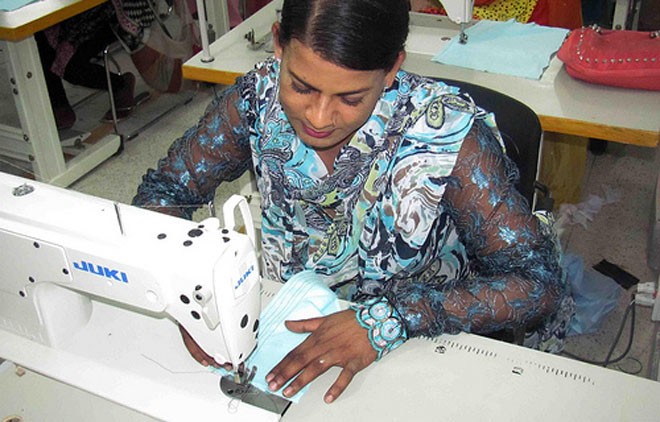
Rural communities, especially women, are learning skills to become resourceful and be a better helping hand to their families

Nazia Mai, 35, has one daughter. After receiving training in Ghotki from a vocational training centre, she can easily support her family. Nazia has also started training other girls at the centre. Uptill now she has trained over 35 girls in different vocations, such as stitching and sewing, etc.
"Before this initiative I used to earn only Rs2,000-3,000 a month and hardly made ends meet. Now things have changed. I’m earning over Rs9,000," she says. The amount may seem little to those residing in big cities but is significant for those who struggle to earn their daily bread.
Changing times have greatly increased the role of women in supporting livelihoods, especially when incomes are limited and expenses increasing. With education bringing awareness in urban centres, the women of today are more aware of the importance of their role in supporting households.
A greater percentage of women work side by side with men in urban areas as compared to, say, a decade ago. However, the situation is a bit different when it comes to rural areas.
In the current scenario, where inflation and poverty is rising at an unprecedented rate, empowerment of women through education, access to free markets is the need of hour so that their families can have a decent standard of living.
In the rural areas of Sindh and Punjab, communities have abandoned their stereotypical approach towards women in supporting livelihoods. These communities are located in ecologically significant areas which need to be protected to ensure sustainability of the ecosystem.
Since people living in the ecologically significant areas are deprived of basic facilities i.e. electricity, therefore, they depend on forest wood for cooking and energy purposes. This has exerted enormous pressure on our forest resources.
There are many non-governmental organisations that are playing their role in empowering women in rural areas. For instance, through a project, Improving Livelihoods of Fisher Communities in Central Indus Wetlands Complex (CIWC), WWF-Pakistan is providing women with kitchen gardening units, fruit saplings, fuel-efficient mud stoves and biogas plants, so that they can value natural resources and play a role in its conservation.
The stoves are much more efficient than the traditional mud stoves, as these fuel-efficient mud stoves consume upto fifty per cent less wood than the traditional ones. They not just help in saving many trees from falling but also emit less smoke.
Biogas plants is another intervention meant to empower communities and helping in conservation as natural gas produced from animal dung is virtually free of cost and helps in reducing dependence on forest wood for consumption purposes.
Upto 130 biogas plants have been provided to them through the project which are contributing towards protecting forests in the area.
Central Indus Wetlands Complex contains three important wetlands; namely Taunsa Barrage Wildlife Sanctuary (TBWS), Kot Mithan Chacharan and the Indus Dolphin Game Reserve. Most importantly, part of the CIWC is included in the Indus ecoregion, a Global 200 Ecoregion, an important route for migratory birds, as it covers a major area of the Indus Flyway. Therefore, community awareness is equally important to keep illegal hunting of migratory birds in check so that populations are not affected.
Since the progress of any society relies on the education and capacity building of women, Vocational Training Centres (VTC’s) have been established in Sukkur, Ghotki and Kashmore in Sindh province, Kot Mithan, Chachran Sharif and Taunsa (Kot Addu) in Punjab province, so that women can be trained and their participation in decision-making can be ensured.
Through community based organisations (CBO’s), women can voice their concerns and find solutions to issues such as the health of their families, alternate income generation options and other issues.
With four vocational training centers in Sukkur; three in Chacharan Sharif and two in Kot Addu, these centres are empowering women who are now competing with men to support their families in changing times.
Vocational trainings are provided in cutting, sewing, stitching, embroidery and handicraft making so that women can stitch clothes and make other traditional goods to earn their livelihood under the supervision of government certified expert trainers.
Women also receive government certification from the Social Welfare Department so that their services are recognised across the country. Linkages have also been developed to urban areas, especially Kashmore and Sukkur, which has enabled women to showcase their products in different markets.
Empowering women has bought a great deal of change, not only in terms of uplifting the monetary situation of poor families, but also helping to reduce their expenses by stitching and sewing clothes which they earlier paid to have made.
Clothing designs are also innovative and reveal traditional Pakistani embroidery and colour combinations. The day is not far when these products will be exported to Western countries.
Other than fuel-efficient mud stoves and biogas plants, 23 kitchen gardening units; 400 household solar units and 12000 fruit saplings have been distributed among marginalised communities, so that they can have alternative livelihood options and reduce their carbon footprint.
One such example is the recent approval of Rs. 110 million project for Taunsa Barrage Wildlife Sanctuary (TBWS) for the implementation of the management plan, initially for a period of two years. This is the result of working closely with the government of Punjab.
These interventions have brought a great deal of change in changing the mindsets of people who earlier used to be ignorant regarding the importance of ecosystem especially forests and species. A chain reaction has already begun which has far reaching benefits.